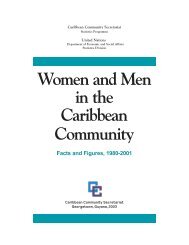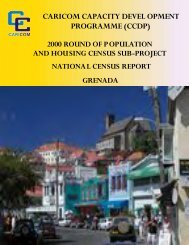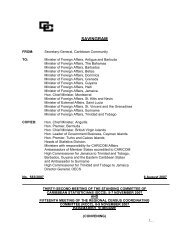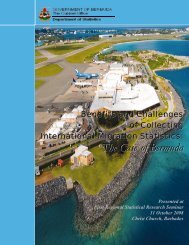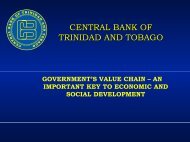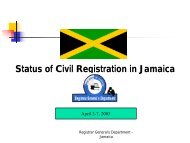CARICOM CAPACITY DEVELOPMENT PROGRAMME (CCDP)
CARICOM CAPACITY DEVELOPMENT PROGRAMME (CCDP)
CARICOM CAPACITY DEVELOPMENT PROGRAMME (CCDP)
You also want an ePaper? Increase the reach of your titles
YUMPU automatically turns print PDFs into web optimized ePapers that Google loves.
National Census Report 2001, St. Vincent and the Grenadinessecondary level schooling. In the population 20 to 24 years, 58.72 per cent had no certification,compared to 72.7 per cent of those in the 40 to 44 age group, and 89.1 per cent of those in the 60and over age group (Table 4.7).It is expected that the percent of those with High School Diploma would be similar to those withCXC and GCE 'O' Level as both could be earned at the end secondary schooling. However,11.39 per cent reported that they earned CXC or GCE 'O' Level passes compared to less than oneper cent that stated they earned a high school diploma. The figures suggest that people considerthe GCE 'O' Level and CXC as higher levels of examination compared to their High SchoolDiploma, and likewise, the GCE 'A' examination as higher than the Associate Degree. Less thanone per cent had Associate Degree compared to 1.43 per cent that had GCE 'A' Level. Comparedto other age groups, the population 20 to 24 years had the highest percentage with GCE 'O'Level/CXC and GCE 'A' Level, 25.71 and 5.59 per cent respectively.The comparative rates at the administrative division level indicate that the 20 to 24 age group inNorth and South Grenadines, Kingstown, Kingstown Suburb and Calliaqua had a higherpercentage with GCE 'O' Level/CXC compared to the national rate for this age group. This sameage group in Kingstown and Calliaqua had a higher percent of 'A' Level passes as compared tothe percentage that passed for the entire country.4.6 Training 11The population 15 years or older in Kingstown, Calliaqua and South Grenadines had the highestexposure to training compared to those in the other administrative divisions, 38.62, 38.60 and38.32 per cent respectively. Those in Colonarie (19.91 per cent) had the least exposure totraining.Overall, males had a higher exposure to training compared to females and this was the case in allthe administrative divisions. However, the sex gap in exposure to training was even morepronounced in Sandy Bay where there were 190 males for every 100 females exposed to training.The gap was narrowest in Kingstown where there were 114 males for every 100 females.11 No table available in this report52



